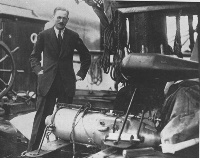|
Sir Alister Hardy:
An ocean colour pioneer
(1896 - 1985)
by Trevor Platt and Venetia Stuart
This article has been commissioned by the IOCCG
and has appeared in the backscatter
magazine, published by the Alliance
of Marine Remote Sensing (AMRS)
British scientist Sir Alister Hardy was one of the pioneers of modern
biological oceanography.
He began his scientific career after demobilisation
from the First World War (during which he served in the Northern Cyclist Battalion).
As a newly-qualified young scientist, he was assigned in the 1920's to study the
relation between herring and its (planktonic) food supply. At that time,
the standard method for assessing the abundance of plankton was to tow a
net behind a slowly-moving ship. The net was made from the fine silk
gauze used in the milling industry for sieving flour. Hardy noticed that
replicate catches made by these nets at closely-spaced stations often
gave quite different values for the local abundance of plankton, even
when the replicate tows were made with the utmost care. He concluded
that this was evidence of an intrinsic variability in the natural
abundance of plankton, decided that such variability must be important,
and devoted a considerable fraction of his career to its study.
He designed and had built the Hardy Continuous Plankton Recorder, an
instrument that could be towed for long distances from ships. Water
flowed through the instrument and through a piece of the same fine silk
used to make plankton nets, capturing a small sample of the plankton.
The forward motion of the ship was used to supply energy to advance the
silk (which was carried in a continuous roll) in discrete steps, such
that a continuous record of plankton abundance could be obtained at the
scale of the ocean basin. This instrument was simple enough to be
deployed by sailors on merchant ships, and thus many line miles of data
could be obtained, which have added enormously to our knowledge of the
structure and function of the marine ecosystem.
A modified version of
this instrument is still being used by the Continuous Plankton Recorder
(CPR) survey, in Plymouth, United Kingdom. This survey is coordinated by
the Sir Alister Hardy Foundation for Ocean Sciences (SAHFOS) which is
supported by grants and awards from several large nations and organizations,
including the Intergovernmental Oceanographic Commission (IOC). Since the
inception of the CPR survey, in 1931, approximately 4 million miles have
been sampled and about 200,000 samples analysed.

Sir Alister Hardy on board the Discovery with his origional Continuous
Plankton Recorder. Photograph reproduced from Great Waters Hardy, 1967
with kind permission of the publishers.
|
Currently, CPR's are
towed over 80,000 nautical miles per year, producing some 4,000 samples
annually. Over several decades, this unique plankton monitoring programme
has provided a comprehensive data set on the spatial and temporal abundance
and distribution patterns of upper layer plankton, on a broad geographical
scale. The results from the CPR survey are now assuming even greater
significance since the database extends from a period when marine pollution,
exploitation and climatic effects were much less pronounced than they are today.
Because the local abundance of phytoplankton is often the principal
determinant of the colour of the ocean, Hardy became interested in the
occurrence and significance of differences in the colour of water
masses. In his classical book `` The Open Sea'' (Hardy, 1956), he writes about the
sharpness of the colour boundaries between water masses containing
different kinds and abundances of plankton. These colour differences are
often so strong that they are easily visible to the unaided human eye,
with the result that they seem to make a line in the sea.
Describing an
overflight of the English Channel, he writes ``In flying from Plymouth
to the western mackerel grounds, we passed over a sharp line separating
the green water of the Channel from the deep blue of the Atlantic;
it ran on a slightly irregular course from the Lizard to the south-west
as far as we could see to the distant horizon. Then while circling over
the mackerel area we saw another equally definite boundary running from
Land's End towards the Scilly Isles separating the deep blue water from
a brown-green area lying to the north.'' Hardy goes on to say ``If these
marked colour-changes can be correctly interpreted we may in the future
find aircraft being used to make rapid surveys of the surface
conditions in relation to fisheries.''
This overflight was made in the early 1920s when manned flight was still a
novelty. Hardy was clearly far ahead of his time in realizing the
significance of spatial differences in the
kinds and abundance of plankton and in devising the means to study them.
Until the advent of satellite remote sensing, the CPR provided the only
means of collecting plankton data at large spatial scales: it was the
remote sensing of the day. Further, by recognizing that colour differences
in the ocean contained important biological information that could be
surveyed rapidly with aircraft (satellites were still a technology of the future),
he became a true pioneer of remotely-sensed ocean-colour science. As well
as being a most distinguished scientist, Hardy was a painter of
outstanding ability. Perhaps it was this combination of talents that
enabled him to see so far into the future of ocean colour.
Reference List
Hardy, A. "The Open Sea", Fisher, J., J. Gilmour, J. Huxley, M. Davies,
and E. Hosking, Eds., Collins, London, 1956.
This article appeared in the
February 1997 issue of the backscatter magazine, published by the
Alliance of Marine Remote
Sensing
Publications & Reports | Home
|